Joachim Steinke
Active Member
- Joined
- Jun 14, 2010
- Messages
- 29
- Reaction score
- 22
Hallo everyone,
here is my version of building a miniature sparkplug.
Needles to say, there are already various publications of surely practicable solutions existing in the web, some had been shown here on HMEM as well. So my report will not contain lots of revolutionary ideas ore totally unknown techniques .ha ha ha ..this is only my variation of the theme.
I intended to use a real small scale plug in my latest engine, so I had bought a single Rimfire Z2 at a model engine exhibition last year. Sadly I damaged it after only a couple of test runs. I must have had too much protein in my breakfast, because I managed to break off the body just above the thread while screwing it in the cylinder head.
Now I was in need of a new one, but Rimfires are not available in German stores, I had to order them in the Netherlands (ore USA) which would take some time for delivery. But, as mostly, I was impatient and wanted to play with my brand new motor, so I decided to build one by myself.
The basic design of a spark plug is no great deal, but which isolating material could be suitable? I have read of Teflon being used, but I had no PTFE in stock and wanted to come forth. So I decided to use Corian, a synthetic material made of Aluminiumhydroxid and PMMA. It has good machining and isolation properties and is heat resistant up to more then 200deg Celsius. I realized that the temperature limit might become a problem, but having no alternative I gave it a try.
Here comes my design, which is clearly comparable to Rimfire as it has to fit in the already existing cylinder head.
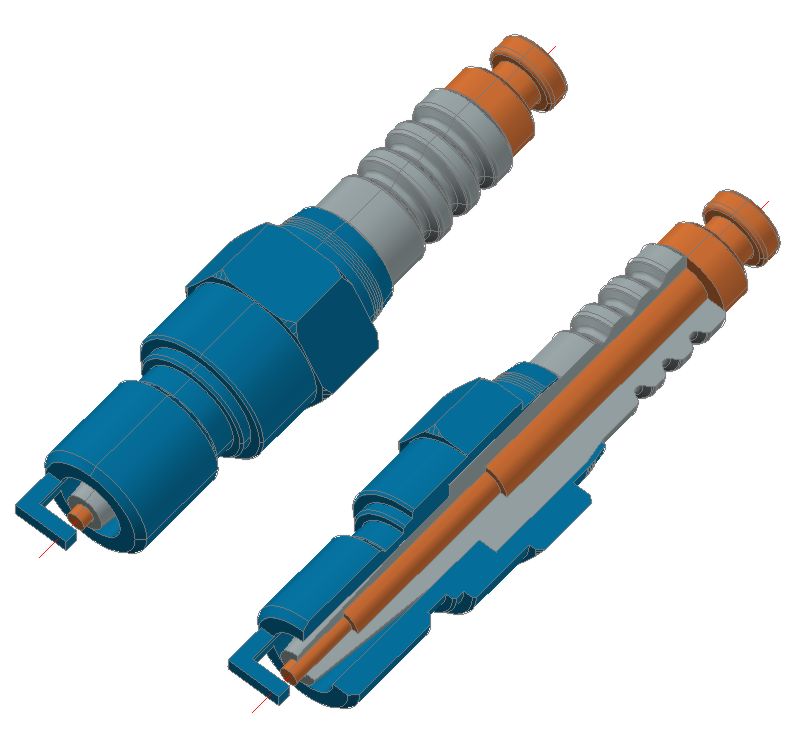
The Z2 is one of the smallest Rimfire plugs, only 0.87in long and with a tiny NS 10-40 thread. This plan shows all the inner details, all measures are in millimetre.
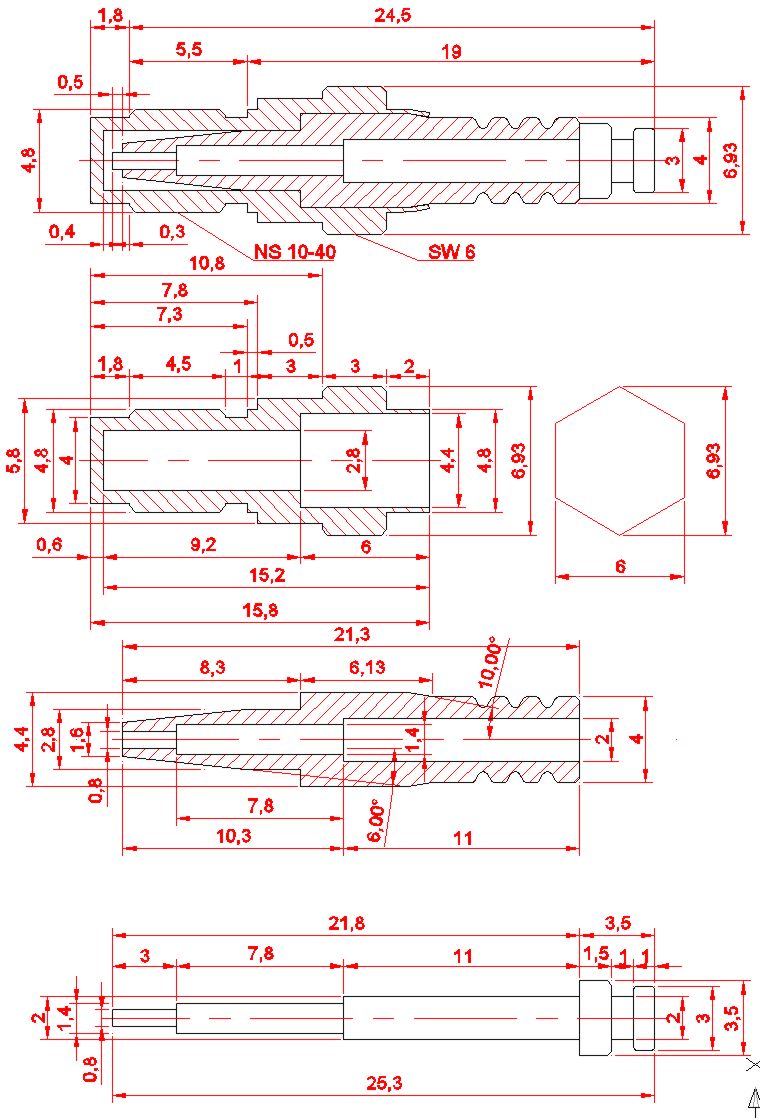
And here some pictures of the making:
Living in Germany, I dont have a threading die for NS 10-40 in my drawers. So the thread is done with the lead screw on the lathe. For the main body (and the electrode too) I used ETG100, a high strength machining steel.
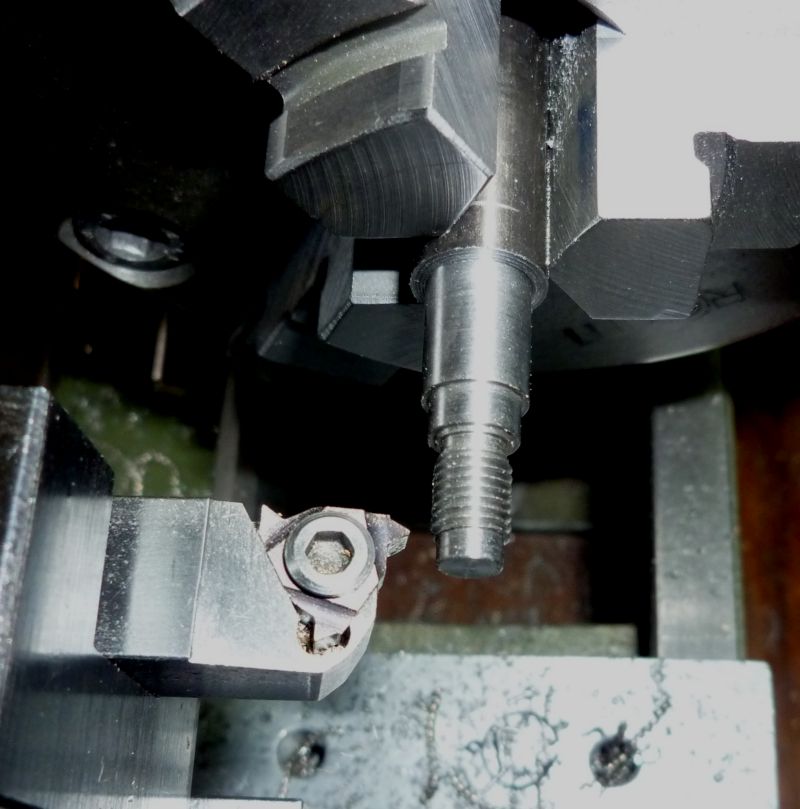
For the graduated inner boring I took one of my Ph-Horn Super Mini massive carbide boring bars. With my smallest version I can go down to a starting hole below 0.04in at a boring length of max. 0.4in, thats some real amazing tooling.
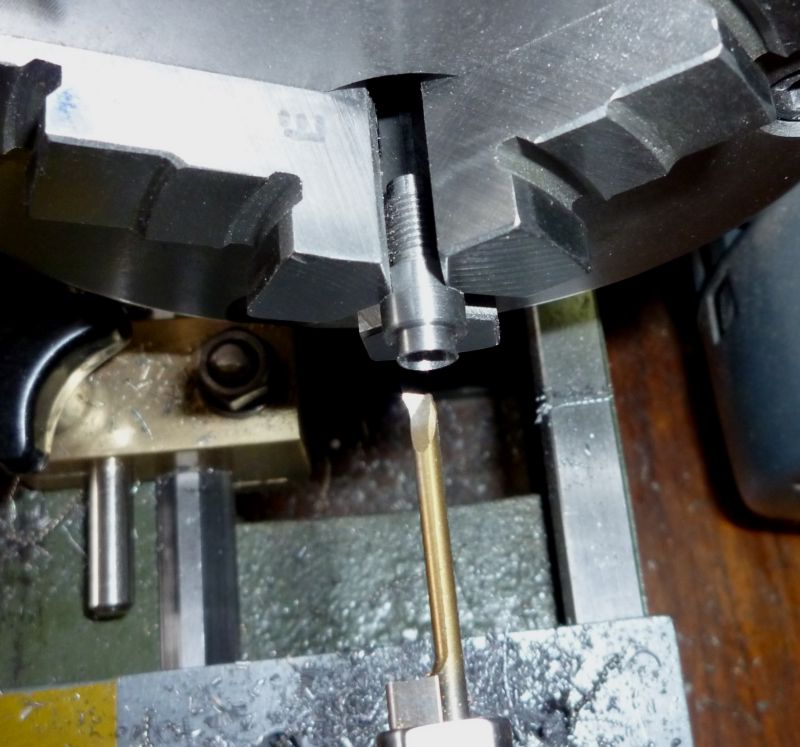
The real fiddly point is the thin part (0.055in diameter) of the electrode. In case of need I have had to build me a little travelling by backrest or on second plan had to hold it very carefully with the tailstock on a thicker lost end. But it was not necessary, as I managed to turn it fully free. The trick is to use a very sharp and suiting cutting tool.
I used a carbide insert CCMT 06, (sharp grinded, highly positive rake angle, radius 0.2mm) and the method is to turn the last passes with the same, relative large infeed. So the final infeed was a reduction of diameter from 0.08in to 0.055in in one pass. And the fine tip of 0.03in was reduced afterwards by holding the part in a small ER11 collet on the 0.08in shaft area.
Sorry, I dont have a picture of that procedure, here its all done and the parting tool is already installed:
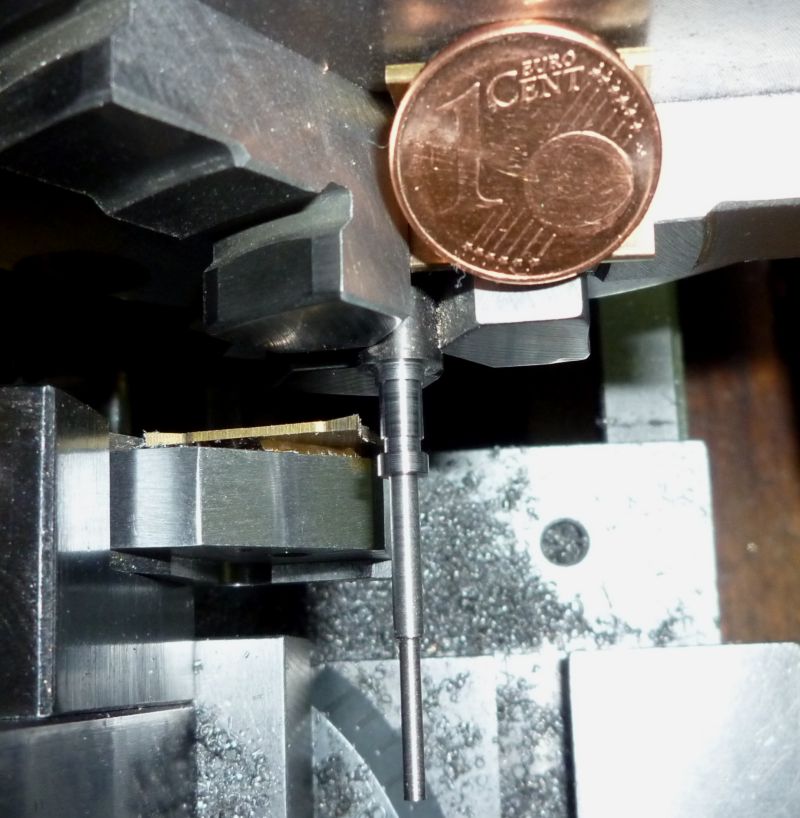
Now it was time for the Corian isolator. Nothing much to mention about that, that stuff is easy to cut like butter .ha ha ha ..
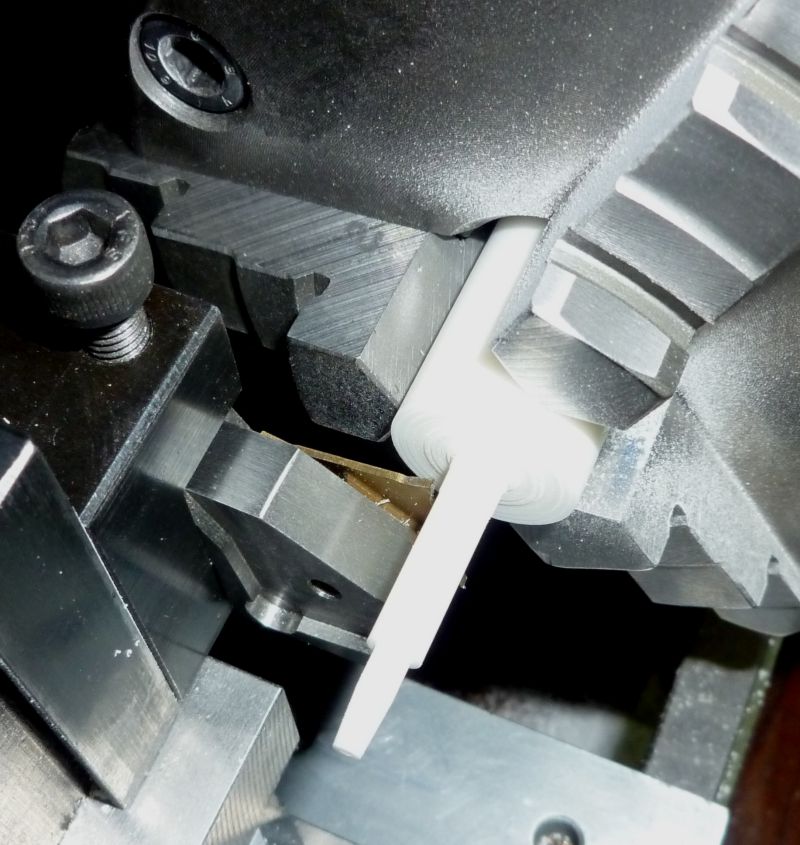
After milling the hex head and the little arm for the negative electrode out of the main body the three parts are ready. As you can see, my electrode is a little bit thicker as the Rimfire one, which is only 0.02in at the tip.
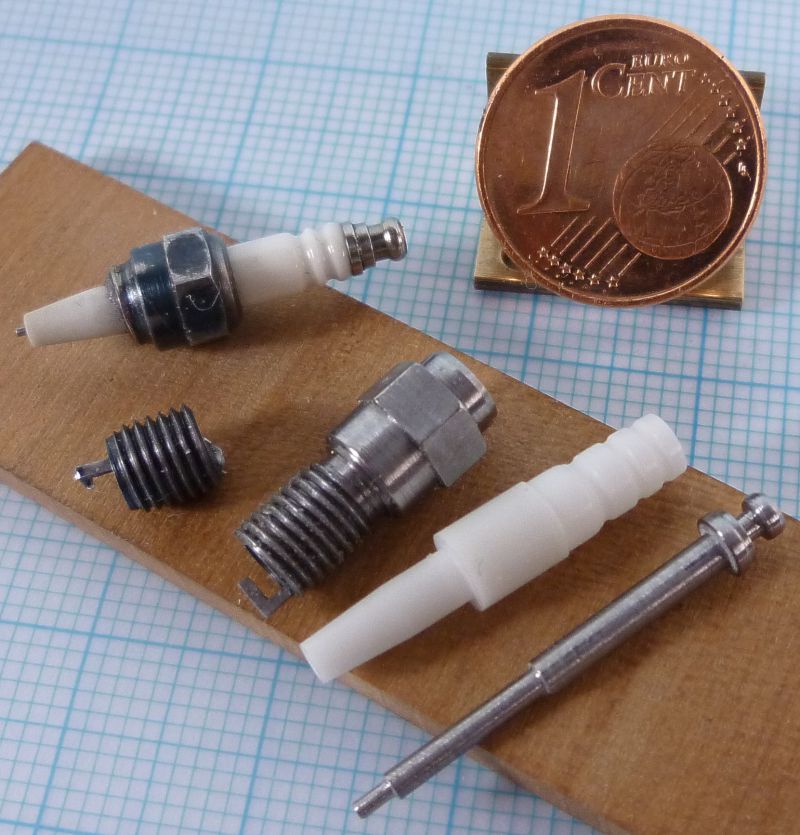
At last I had to join the parts. The electrode is bonded with 2 components epoxy (Araldit) in the Corian part. There is a long area for bonding, so that should be solid enough. The isolator is also bonded in at first stage, and in addition I pressed the thin flange of the main body around the shaft, using a ball bearing as a spinning tool on the lathe.
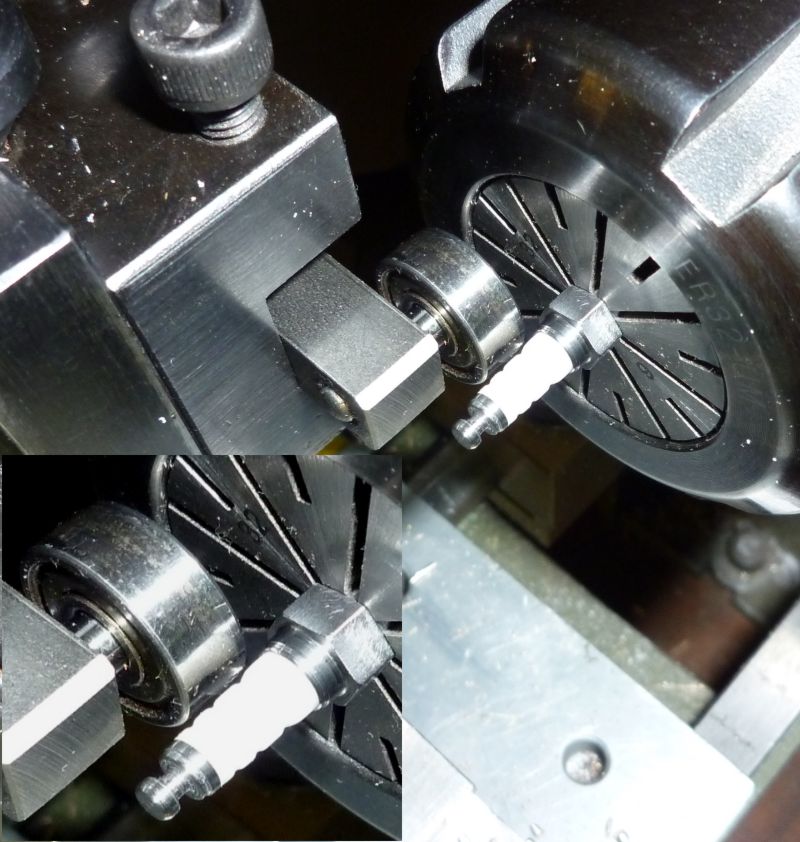
Voila, all done, the original Rimfire in direct comparison to my version:
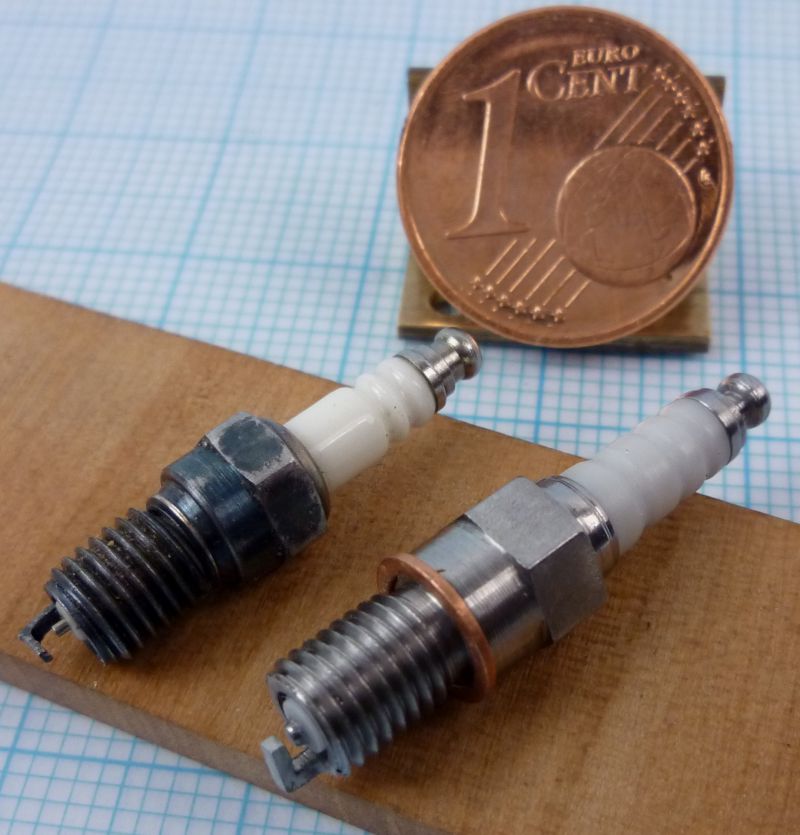
Okay, the plug is working well, especially for starting and midrange speed. To my impression the ignition becomes a bit instable at full speed. With the Rimfire the engine runs over 7000rpm (even 8000) for longer periods without any problem, with my own it tends to have some ignition misses above the 6000rpm mark.
But the effect is more temporary and not so serious. It can also depend on some instability of my home made ignition system, which will be the reason for some specific questions I want to ask here in the next days.
Nevertheless, when the new Rimfire where delivered I switched over to the commercial ones again .ha ha ha .
At very last a picture of a Rimfire and my own plug after some time of use.
The Rimfire has definitely seen more than one hour of full speed, my plug has a running time of approximately 30min. Both plugs are not cleaned with abrasive procedures like brushing them with steel wool or so, they are only cleaned with a soft paint brush and some acetone.
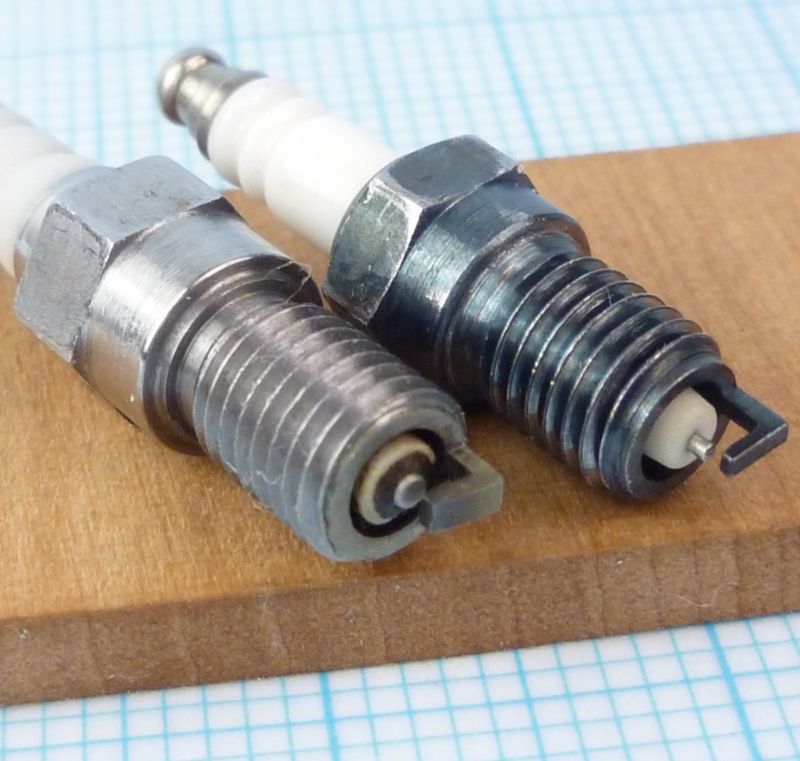
As you can see, there is a brown ring around the electrode of my plug. I believe this is some epoxy material coming out of the boring under the influence of heat. Perhaps I was too generous with the glue, it sure had been sufficient to use it on the upper shaft region only. The Corian seems to have no problem with the temperature, in any case I cant detect some visual changes on the outer surface. The isolation seems to by all right too, the sparks are coming precise and without any misfiring. So to my opinion the material seems to be quite practical for a spark plug isolator.
On the other hand, I dont think it makes much sense to make your own plugs at all. A lot of work and there is still the remaining uncertainty of a final and serious function in your engine. The ignition system is a very important end sensitive component, many builders with running problems dont realize that and believe the reasons lay on the carburator side or they depend on a false valve timing etc. Its wise to ensure the proper function of the ignition at first priority, might avoid a lot of trouble.
And last but not least it depends on the specific purpose. A slow engine, which works from time to time for some minutes, might by happy with a not so optimal spark plug, but a fast and hot running motor has higher demands for a perfect and reliable function.
Achim
here is my version of building a miniature sparkplug.
Needles to say, there are already various publications of surely practicable solutions existing in the web, some had been shown here on HMEM as well. So my report will not contain lots of revolutionary ideas ore totally unknown techniques .ha ha ha ..this is only my variation of the theme.
I intended to use a real small scale plug in my latest engine, so I had bought a single Rimfire Z2 at a model engine exhibition last year. Sadly I damaged it after only a couple of test runs. I must have had too much protein in my breakfast, because I managed to break off the body just above the thread while screwing it in the cylinder head.
Now I was in need of a new one, but Rimfires are not available in German stores, I had to order them in the Netherlands (ore USA) which would take some time for delivery. But, as mostly, I was impatient and wanted to play with my brand new motor, so I decided to build one by myself.
The basic design of a spark plug is no great deal, but which isolating material could be suitable? I have read of Teflon being used, but I had no PTFE in stock and wanted to come forth. So I decided to use Corian, a synthetic material made of Aluminiumhydroxid and PMMA. It has good machining and isolation properties and is heat resistant up to more then 200deg Celsius. I realized that the temperature limit might become a problem, but having no alternative I gave it a try.
Here comes my design, which is clearly comparable to Rimfire as it has to fit in the already existing cylinder head.

The Z2 is one of the smallest Rimfire plugs, only 0.87in long and with a tiny NS 10-40 thread. This plan shows all the inner details, all measures are in millimetre.

And here some pictures of the making:
Living in Germany, I dont have a threading die for NS 10-40 in my drawers. So the thread is done with the lead screw on the lathe. For the main body (and the electrode too) I used ETG100, a high strength machining steel.

For the graduated inner boring I took one of my Ph-Horn Super Mini massive carbide boring bars. With my smallest version I can go down to a starting hole below 0.04in at a boring length of max. 0.4in, thats some real amazing tooling.

The real fiddly point is the thin part (0.055in diameter) of the electrode. In case of need I have had to build me a little travelling by backrest or on second plan had to hold it very carefully with the tailstock on a thicker lost end. But it was not necessary, as I managed to turn it fully free. The trick is to use a very sharp and suiting cutting tool.
I used a carbide insert CCMT 06, (sharp grinded, highly positive rake angle, radius 0.2mm) and the method is to turn the last passes with the same, relative large infeed. So the final infeed was a reduction of diameter from 0.08in to 0.055in in one pass. And the fine tip of 0.03in was reduced afterwards by holding the part in a small ER11 collet on the 0.08in shaft area.
Sorry, I dont have a picture of that procedure, here its all done and the parting tool is already installed:

Now it was time for the Corian isolator. Nothing much to mention about that, that stuff is easy to cut like butter .ha ha ha ..

After milling the hex head and the little arm for the negative electrode out of the main body the three parts are ready. As you can see, my electrode is a little bit thicker as the Rimfire one, which is only 0.02in at the tip.

At last I had to join the parts. The electrode is bonded with 2 components epoxy (Araldit) in the Corian part. There is a long area for bonding, so that should be solid enough. The isolator is also bonded in at first stage, and in addition I pressed the thin flange of the main body around the shaft, using a ball bearing as a spinning tool on the lathe.

Voila, all done, the original Rimfire in direct comparison to my version:

Okay, the plug is working well, especially for starting and midrange speed. To my impression the ignition becomes a bit instable at full speed. With the Rimfire the engine runs over 7000rpm (even 8000) for longer periods without any problem, with my own it tends to have some ignition misses above the 6000rpm mark.
But the effect is more temporary and not so serious. It can also depend on some instability of my home made ignition system, which will be the reason for some specific questions I want to ask here in the next days.
Nevertheless, when the new Rimfire where delivered I switched over to the commercial ones again .ha ha ha .
At very last a picture of a Rimfire and my own plug after some time of use.
The Rimfire has definitely seen more than one hour of full speed, my plug has a running time of approximately 30min. Both plugs are not cleaned with abrasive procedures like brushing them with steel wool or so, they are only cleaned with a soft paint brush and some acetone.

As you can see, there is a brown ring around the electrode of my plug. I believe this is some epoxy material coming out of the boring under the influence of heat. Perhaps I was too generous with the glue, it sure had been sufficient to use it on the upper shaft region only. The Corian seems to have no problem with the temperature, in any case I cant detect some visual changes on the outer surface. The isolation seems to by all right too, the sparks are coming precise and without any misfiring. So to my opinion the material seems to be quite practical for a spark plug isolator.
On the other hand, I dont think it makes much sense to make your own plugs at all. A lot of work and there is still the remaining uncertainty of a final and serious function in your engine. The ignition system is a very important end sensitive component, many builders with running problems dont realize that and believe the reasons lay on the carburator side or they depend on a false valve timing etc. Its wise to ensure the proper function of the ignition at first priority, might avoid a lot of trouble.
And last but not least it depends on the specific purpose. A slow engine, which works from time to time for some minutes, might by happy with a not so optimal spark plug, but a fast and hot running motor has higher demands for a perfect and reliable function.
Achim




